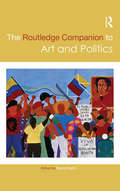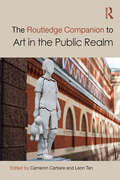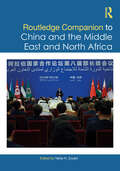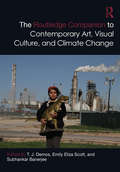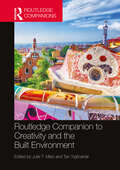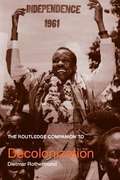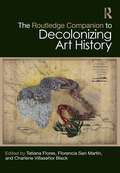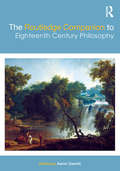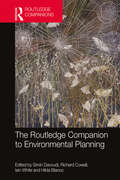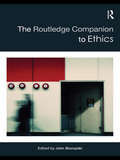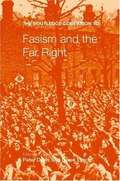- Table View
- List View
The Routledge Companion to African American Art History (Routledge Art History and Visual Studies Companions)
by Eddie ChambersThis Companion authoritatively points to the main areas of enquiry within the subject of African American art history. The first section examines how African American art has been constructed over the course of a century of published scholarship. The second section studies how African American art is and has been taught and researched in academia. The third part focuses on how African American art has been reflected in art galleries and museums. The final section opens up understandings of what we mean when we speak of African American art. This book will be of interest to graduate students, researchers, and professors and may be used in American art, African American art, visual culture, and culture classes.
The Routledge Companion to African American Art History (Routledge Art History and Visual Studies Companions)
by Eddie ChambersThis Companion authoritatively points to the main areas of enquiry within the subject of African American art history. The first section examines how African American art has been constructed over the course of a century of published scholarship. The second section studies how African American art is and has been taught and researched in academia. The third part focuses on how African American art has been reflected in art galleries and museums. The final section opens up understandings of what we mean when we speak of African American art. This book will be of interest to graduate students, researchers, and professors and may be used in American art, African American art, visual culture, and culture classes.
The Routledge Companion to Art and Activism in the Twenty-First Century (Routledge Art History and Visual Studies Companions)
by Lesley Shipley Mey-Yen MoriuchiThe Routledge Companion to Art and Activism in the Twenty-First Century brings together a wide range of geographical, cultural, historical, and conceptual perspectives in a single volume of new essays that facilitate a deeper understanding of the field of art activism as it stands today and as it looks towards the future. The book is a resource for multiple fields, including art activism, socially engaged art, and contemporary art, that represent the depth and breadth of contemporary activist art worldwide. Contributors highlight predominant lines of inquiry, uncover challenges faced by scholars and practitioners of activist art, and facilitate dialogue that might lead to new directions for research and practice. The editors hope that the volume will incite further conversation and collaboration among the various participants, practitioners, and researchers concerned with the relationship between art and activism. The audience includes scholars and professors of modern and contemporary art, students in both graduate and upper-level undergraduate programs, as well as artists, curators, and museum professionals. Each chapter can stand on its own, making the companion a flexible resource for students and educators working in art history, museum studies, community practice/socially engaged art, political science, sociology, and ethnic and cultural studies.
The Routledge Companion to Art and Activism in the Twenty-First Century (Routledge Art History and Visual Studies Companions)
by Lesley Shipley Mey-Yen MoriuchiThe Routledge Companion to Art and Activism in the Twenty-First Century brings together a wide range of geographical, cultural, historical, and conceptual perspectives in a single volume of new essays that facilitate a deeper understanding of the field of art activism as it stands today and as it looks towards the future. The book is a resource for multiple fields, including art activism, socially engaged art, and contemporary art, that represent the depth and breadth of contemporary activist art worldwide. Contributors highlight predominant lines of inquiry, uncover challenges faced by scholars and practitioners of activist art, and facilitate dialogue that might lead to new directions for research and practice. The editors hope that the volume will incite further conversation and collaboration among the various participants, practitioners, and researchers concerned with the relationship between art and activism. The audience includes scholars and professors of modern and contemporary art, students in both graduate and upper-level undergraduate programs, as well as artists, curators, and museum professionals. Each chapter can stand on its own, making the companion a flexible resource for students and educators working in art history, museum studies, community practice/socially engaged art, political science, sociology, and ethnic and cultural studies.
The Routledge Companion to Art and Politics (Routledge Art History and Visual Studies Companions)
by Randy MartinThe Routledge Companion to Art and Politics offers a thorough examination of the complex relationship between art and politics, and the many forms and approaches the engagement between them can take. The contributors - a diverse assembly of artists, activists, scholars from around the world – discuss and demonstrate ways of making art and politics legible and salient in the world. As such the 32 chapters in this volume reflect on performing and visual arts; music, film and new media; as well as covering social practice, community-based work, conceptual, interventionist and movement affiliated forms. The Companion is divided into four distinct parts: Conceptual Cartographies Institutional Materialities Modalities of Practice Making Publics Randy Martin has assembled a collection that ensures that readers will come away with a wider view of what can count as art and politics; where they might find it; and how it moves in the world. The diversity of perspectives is at once challenging and fortifying to those who might dismiss political art on the one hand as not making sufficient difference and on the other to those embracing it but seeking a means to elaborate the significance that it can make in the world. The Routledge Companion to Art and Politics brings together a range of issues and approaches and encourages critical and creative thinking about how art is produced, perceived, and received.
The Routledge Companion to Art and Politics (Routledge Art History and Visual Studies Companions)
by Randy Martin Victor J. PetersonThe Routledge Companion to Art and Politics offers a thorough examination of the complex relationship between art and politics, and the many forms and approaches the engagement between them can take. The contributors - a diverse assembly of artists, activists, scholars from around the world – discuss and demonstrate ways of making art and politics legible and salient in the world. As such the 32 chapters in this volume reflect on performing and visual arts; music, film and new media; as well as covering social practice, community-based work, conceptual, interventionist and movement affiliated forms. The Companion is divided into four distinct parts: Conceptual Cartographies Institutional Materialities Modalities of Practice Making Publics Randy Martin has assembled a collection that ensures that readers will come away with a wider view of what can count as art and politics; where they might find it; and how it moves in the world. The diversity of perspectives is at once challenging and fortifying to those who might dismiss political art on the one hand as not making sufficient difference and on the other to those embracing it but seeking a means to elaborate the significance that it can make in the world. The Routledge Companion to Art and Politics brings together a range of issues and approaches and encourages critical and creative thinking about how art is produced, perceived, and received.
The Routledge Companion to Art in the Public Realm (Routledge Art History and Visual Studies Companions)
by Cameron CartiereThis multidisciplinary companion offers a comprehensive overview of the global arena of public art.It is organised around four distinct topics: activation, social justice, memory and identity, and ecology, with a final chapter mapping significant works of public and social practice art around the world between 2008 and 2018. The thematic approach brings into view similarities and differences in the recent globalisation of public art practices, while the multidisciplinary emphasis allows for a consideration of the complex outcomes and consequences of such practices, as they engage different disciplines and communities and affect a diversity of audiences beyond the existing 'art world'. The book will highlight an international selection of artist projects that illustrate the themes.This book will be of interest to scholars in contemporary art, art history, urban studies, and museum studies.
The Routledge Companion to Art in the Public Realm (Routledge Art History and Visual Studies Companions)
by Cameron Cartiere Leon TanThis multidisciplinary companion offers a comprehensive overview of the global arena of public art.It is organised around four distinct topics: activation, social justice, memory and identity, and ecology, with a final chapter mapping significant works of public and social practice art around the world between 2008 and 2018. The thematic approach brings into view similarities and differences in the recent globalisation of public art practices, while the multidisciplinary emphasis allows for a consideration of the complex outcomes and consequences of such practices, as they engage different disciplines and communities and affect a diversity of audiences beyond the existing 'art world'. The book will highlight an international selection of artist projects that illustrate the themes.This book will be of interest to scholars in contemporary art, art history, urban studies, and museum studies.
Routledge Companion to China and the Middle East and North Africa
by Yahia H ZoubirFocusing on China’s relations with the Middle East and North Africa (MENA), this Companion provides essential analysis of a complex region which threatens to become the battleground for rival powers in the future. The Routledge Companion to China and the Middle East and North Africa brings together China scholars from around the world, including from China, the MENA region, the United States, Asia, and Europe. The contributors, experts in their respective areas––which range from politics, military and nuclear power to economics, energy, and tourism––use different methodologies to understand China’s policies in the MENA. Topics analyzed include Chinese investment in infrastructure, the COVID- 19 pandemic and the Belt and Road Initiative. Divided into three Parts, the book addresses China’s multidimensional presence in the MENA and its impact on the region while also explicating the MENA’s relations with its traditional Western allies. Bilateral relations and people- to- people interactions are also explored and provide in-depth context to the areas of cooperation that are part of China’s dealings with its partners in the region. Combining contemporary analysis with accessible prose, the book will be of interest to students, scholars, and policy- makers active in international relations, security studies, and economics, as well to general audiences interested in the MENA region.
Routledge Companion to China and the Middle East and North Africa
by Yahia H. ZoubirFocusing on China’s relations with the Middle East and North Africa (MENA), this Companion provides essential analysis of a complex region which threatens to become the battleground for rival powers in the future. The Routledge Companion to China and the Middle East and North Africa brings together China scholars from around the world, including from China, the MENA region, the United States, Asia, and Europe. The contributors, experts in their respective areas––which range from politics, military and nuclear power to economics, energy, and tourism––use different methodologies to understand China’s policies in the MENA. Topics analyzed include Chinese investment in infrastructure, the COVID- 19 pandemic and the Belt and Road Initiative. Divided into three Parts, the book addresses China’s multidimensional presence in the MENA and its impact on the region while also explicating the MENA’s relations with its traditional Western allies. Bilateral relations and people- to- people interactions are also explored and provide in-depth context to the areas of cooperation that are part of China’s dealings with its partners in the region. Combining contemporary analysis with accessible prose, the book will be of interest to students, scholars, and policy- makers active in international relations, security studies, and economics, as well to general audiences interested in the MENA region.
The Routledge Companion to Contemporary Art, Visual Culture, and Climate Change (Routledge Art History and Visual Studies Companions)
by T. J. Demos Emily Eliza Scott Subhankar BanerjeeInternational in scope, this volume brings together leading and emerging voices working at the intersection of contemporary art, visual culture, activism, and climate change, and addresses key questions, such as: why and how do art and visual culture, and their ethics and values, matter with regard to a world increasingly shaped by climate breakdown? Foregrounding a decolonial and climate-justice-based approach, this book joins efforts within the environmental humanities in seeking to widen considerations of climate change as it intersects with social, political, and cultural realms. It simultaneously expands the nascent branches of ecocritical art history and visual culture, and builds toward the advancement of a robust and critical interdisciplinarity appropriate to the complex entanglements of climate change. This book will be of special interest to scholars and practitioners of contemporary art and visual culture, environmental studies, cultural geography, and political ecology.
The Routledge Companion to Contemporary Art, Visual Culture, and Climate Change (Routledge Art History and Visual Studies Companions)
by T. J. Demos Emily Eliza Scott Subhankar BanerjeeInternational in scope, this volume brings together leading and emerging voices working at the intersection of contemporary art, visual culture, activism, and climate change, and addresses key questions, such as: why and how do art and visual culture, and their ethics and values, matter with regard to a world increasingly shaped by climate breakdown? Foregrounding a decolonial and climate-justice-based approach, this book joins efforts within the environmental humanities in seeking to widen considerations of climate change as it intersects with social, political, and cultural realms. It simultaneously expands the nascent branches of ecocritical art history and visual culture, and builds toward the advancement of a robust and critical interdisciplinarity appropriate to the complex entanglements of climate change. This book will be of special interest to scholars and practitioners of contemporary art and visual culture, environmental studies, cultural geography, and political ecology.
Routledge Companion to Creativity and the Built Environment (Routledge International Handbooks)
by Julie T. Miao Tan YigitcanlarThis book crtitically examines the reciprocal relationship between creativity and the built environment and features leading voices from across the world in a debate on originating, learning, modifying, and plagiarizing creativities within the built environment.The Companion includes contributions from architecture, design, planning, construction, real estate, economics, urban studies, geography, sociology, and public policies. Contributors review the current field and proposes new conceptual frameworks, research methodologies, and directions for research, policy, and practice. Chapters are organised into five sections, each drawing on cross-disciplinary insights and debates: Section I connects creativity, productivity, and economic growth and examines how our built environment stimulates or intimidates human imaginations. Section II addresses how hard environments are fabricated with social, cultural, and institutional meanings, and how these evolve in different times and settings. Section III discusses activities that directly and indirectly shape the material development of a built environment, its environmental sustainability, space utility, and place identity. Section IV illustrates how technologies and innovations are used in building and strengthening an intelligent, real-time, responsive urban agenda. Section V examines governance opportunities and challenges at the interface between creativity and built environment. An important resource for scholars and students in the fields of urban planning and development, urban studies, environmental sustainability, human geography, sociology, and public policy.
Routledge Companion to Creativity and the Built Environment (Routledge International Handbooks)
This book crtitically examines the reciprocal relationship between creativity and the built environment and features leading voices from across the world in a debate on originating, learning, modifying, and plagiarizing creativities within the built environment.The Companion includes contributions from architecture, design, planning, construction, real estate, economics, urban studies, geography, sociology, and public policies. Contributors review the current field and proposes new conceptual frameworks, research methodologies, and directions for research, policy, and practice. Chapters are organised into five sections, each drawing on cross-disciplinary insights and debates: Section I connects creativity, productivity, and economic growth and examines how our built environment stimulates or intimidates human imaginations. Section II addresses how hard environments are fabricated with social, cultural, and institutional meanings, and how these evolve in different times and settings. Section III discusses activities that directly and indirectly shape the material development of a built environment, its environmental sustainability, space utility, and place identity. Section IV illustrates how technologies and innovations are used in building and strengthening an intelligent, real-time, responsive urban agenda. Section V examines governance opportunities and challenges at the interface between creativity and built environment. An important resource for scholars and students in the fields of urban planning and development, urban studies, environmental sustainability, human geography, sociology, and public policy.
The Routledge Companion To Decolonization (PDF)
by Dietmar RothermundThis is an essential companion to the process of decolonization #65533; perhaps one of the most important historical processes of the twentieth century. Examining decolonization in Africa, Asia, the Caribbean and the Pacific, the Companion includes: thematic chapters a detailed chronology and thorough glossary biographies of key figures maps. Providing comprehensive coverage of a broad and complex subject area, the guide explores: the global context for decolonization nationalism and the rise of resistance movements resistance by white settlers and moves towards independence Hong Kong and Macau, and decolonization in the late twentieth century debates surrounding neo-colonialism, and the rise of #65533;development#65533; projects and aid the legacy of colonialism in law, education, administration and the military. With suggestions for further reading, and a guide to sources, this is an invaluable resource for students and scholars of the colonial and post-colonial eras, and is an indispensable guide to the reshaping of the world in the twentieth century.
The Routledge Companion to Decolonizing Art History (Routledge Art History and Visual Studies Companions)
by Tatiana Flores Florencia San Martín Charlene Villaseñor BlackThis companion is the first global, comprehensive text to explicate, theorize, and propose decolonial methodologies for art historians, museum professionals, artists, and other visual culture scholars, teachers, and practitioners.Art history as a discipline and its corollary institutions - the museum, the art market - are not only products of colonial legacies but active agents in the consolidation of empire and the construction of the West. The Routledge Companion to Decolonizing Art History joins the growing critical discourse around the decolonial through an assessment of how art history may be rethought and mobilized in the service of justice - racial, gender, social, environmental, restorative, and more. This book draws attention to the work of artists, art historians, and scholars in related fields who have been engaging with disrupting master narratives and forging new directions, often within a hostile academy or an indifferent art world. The volume unpacks the assumptions projected onto objects of art and visual culture and the discourse that contains them. It equally addresses the manifold complexities around representation as visual and discursive praxis through a range of epistemologies and metaphors originated outside or against the logic of modernity. This companion is organized into four thematic sections: Being and Doing, Learning and Listening, Sensing and Seeing, and Living and Loving.The book will be of interest to scholars working in art history, visual culture, museum studies, race and ethnic studies, cultural studies, disability studies, and women’s, gender, and sexuality studies.
The Routledge Companion to Decolonizing Art History (Routledge Art History and Visual Studies Companions)
This companion is the first global, comprehensive text to explicate, theorize, and propose decolonial methodologies for art historians, museum professionals, artists, and other visual culture scholars, teachers, and practitioners.Art history as a discipline and its corollary institutions - the museum, the art market - are not only products of colonial legacies but active agents in the consolidation of empire and the construction of the West. The Routledge Companion to Decolonizing Art History joins the growing critical discourse around the decolonial through an assessment of how art history may be rethought and mobilized in the service of justice - racial, gender, social, environmental, restorative, and more. This book draws attention to the work of artists, art historians, and scholars in related fields who have been engaging with disrupting master narratives and forging new directions, often within a hostile academy or an indifferent art world. The volume unpacks the assumptions projected onto objects of art and visual culture and the discourse that contains them. It equally addresses the manifold complexities around representation as visual and discursive praxis through a range of epistemologies and metaphors originated outside or against the logic of modernity. This companion is organized into four thematic sections: Being and Doing, Learning and Listening, Sensing and Seeing, and Living and Loving.The book will be of interest to scholars working in art history, visual culture, museum studies, race and ethnic studies, cultural studies, disability studies, and women’s, gender, and sexuality studies.
The Routledge Companion to Eighteenth Century Philosophy (Routledge Philosophy Companions)
by Aaron GarrettThe Eighteenth century is one of the most important periods in the history of Western philosophy, witnessing philosophical, scientific, and social and political change on a vast scale. In spite of this, there are few single volume overviews of the philosophy of the period as a whole. The Routledge Companion to Eighteenth Century Philosophy is an authoritative survey and assessment of this momentous period, covering major thinkers, topics and movements in Eighteenth century philosophy. Beginning with a substantial introduction by Aaron Garrett, the thirty-five specially commissioned chapters by an outstanding team of international contributors are organised into seven clear parts: Context and Movements Metaphysics and Understanding Mind, Soul, and Perception Morals and Aesthetics Politics and Society Philosophy in relation to the Arts and Sciences Major Figures. Major topics and themes are explored and discussed, ranging from materialism, free will and personal identity; to the emotions, the social contract, aesthetics, and the sciences, including mathematics and biology. The final section examines in more detail three figures central to the period: Hume, Rousseau and Kant. As such The Routledge Companion to Eighteenth Century Philosophy is essential reading for all students of the period, both in philosophy and related disciplines such as politics, literature, history and religious studies.
The Routledge Companion to Eighteenth Century Philosophy (Routledge Philosophy Companions)
by Aaron Garrett Aaron V. GarrettThe Eighteenth century is one of the most important periods in the history of Western philosophy, witnessing philosophical, scientific, and social and political change on a vast scale. In spite of this, there are few single volume overviews of the philosophy of the period as a whole. The Routledge Companion to Eighteenth Century Philosophy is an authoritative survey and assessment of this momentous period, covering major thinkers, topics and movements in Eighteenth century philosophy. Beginning with a substantial introduction by Aaron Garrett, the thirty-five specially commissioned chapters by an outstanding team of international contributors are organised into seven clear parts: Context and Movements Metaphysics and Understanding Mind, Soul, and Perception Morals and Aesthetics Politics and Society Philosophy in relation to the Arts and Sciences Major Figures. Major topics and themes are explored and discussed, ranging from materialism, free will and personal identity; to the emotions, the social contract, aesthetics, and the sciences, including mathematics and biology. The final section examines in more detail three figures central to the period: Hume, Rousseau and Kant. As such The Routledge Companion to Eighteenth Century Philosophy is essential reading for all students of the period, both in philosophy and related disciplines such as politics, literature, history and religious studies.
The Routledge Companion to Environmental Planning (Routledge International Handbooks)
by Simin Davoudi Richard Cowell Iain White Hilda BlancoThis Companion presents a distinctive approach to environmental planning by: situating the debate in its social, cultural, political and institutional context; being attentive to depth and breadth of discussions; providing up-to-date accounts of the contemporary practices in environmental planning and their changes over time; adopting multiple theoretical and analytical lenses and different disciplinary approaches; and drawing on knowledge and expertise of a wide range of leading international scholars from across the social science disciplines and beyond. It aims to provide critical reviews of the state-of-the-art theoretical and practical approaches as well as empirical knowledge and understandings of environmental planning; encourage dialogue across disciplines and national policy contexts about a wide range of environmental planning themes; and, engage with and reflect on politics, policies, practices and decision-making tools in environmental planning. The Companion provides a deeper understanding of the interdependencies between the themes in the four parts of the book (Understanding ‘the environment’, Environmental governance, Critical environmental pressures and responses, and Methods and approaches to environmental planning) and its 37 chapters. It presents critical perspectives on the role of meanings, values, governance, approaches and participations in environmental planning. Situating environmental planning debates in the wider ecological, political, ethical, institutional, social and cultural debates, it aims to shine light on some of the critical journeys that we have traversed and those that we are yet to navigate and their implications for environmental planning research and practice. The Companion provides a reference point mapping out the terrain of environmental planning in an international and multidisciplinary context. The depth and breadth of discussions by leading international scholars make it relevant to and useful for those who are curious about, wish to learn more, want to make sense of, and care for the environment within the field of environmental planning and beyond.
The Routledge Companion to Environmental Planning (Routledge International Handbooks)
by Simin Davoudi Richard Cowell Iain White Hilda BlancoThis Companion presents a distinctive approach to environmental planning by: situating the debate in its social, cultural, political and institutional context; being attentive to depth and breadth of discussions; providing up-to-date accounts of the contemporary practices in environmental planning and their changes over time; adopting multiple theoretical and analytical lenses and different disciplinary approaches; and drawing on knowledge and expertise of a wide range of leading international scholars from across the social science disciplines and beyond. It aims to provide critical reviews of the state-of-the-art theoretical and practical approaches as well as empirical knowledge and understandings of environmental planning; encourage dialogue across disciplines and national policy contexts about a wide range of environmental planning themes; and, engage with and reflect on politics, policies, practices and decision-making tools in environmental planning. The Companion provides a deeper understanding of the interdependencies between the themes in the four parts of the book (Understanding ‘the environment’, Environmental governance, Critical environmental pressures and responses, and Methods and approaches to environmental planning) and its 37 chapters. It presents critical perspectives on the role of meanings, values, governance, approaches and participations in environmental planning. Situating environmental planning debates in the wider ecological, political, ethical, institutional, social and cultural debates, it aims to shine light on some of the critical journeys that we have traversed and those that we are yet to navigate and their implications for environmental planning research and practice. The Companion provides a reference point mapping out the terrain of environmental planning in an international and multidisciplinary context. The depth and breadth of discussions by leading international scholars make it relevant to and useful for those who are curious about, wish to learn more, want to make sense of, and care for the environment within the field of environmental planning and beyond.
The Routledge Companion to Ethics (Routledge Philosophy Companions)
by John SkorupskiThe Routledge Companion to Ethics is an outstanding survey of the whole field of ethics by a distinguished international team of contributors. Over 60 chapters are divided into six clear sections: the history of ethics meta-ethics perspectives from outside ethics ethical perspectives morality debates in ethics. The Companion opens with a comprehensive historical overview of ethics, including chapters on Plato, Aristotle, Hume, and Kant, and ethical thinking in China, India and the Arabic tradition. The second part covers the domain of meta-ethics. The third part covers important challenges to ethics from the fields of anthropology, psychology, sociobiology and economics. The fourth and fifth sections cover competing theories of ethics and the nature of morality respectively, with entries on consequentialism, Kantian morality, virtue ethics, relativism, evil, and responsibility amongst many others. A comprehensive final section includes the most important topics and controversies in applied ethics, such as rights, justice and distribution, the end of life, the environment, poverty, war and terrorism. The Routledge Companion to Ethics is a superb resource for anyone interested in the subject, whether in philosophy or related disciplines such as politics, education, or law. Fully indexed and cross-referenced, with helpful further reading sections at the end of each chapter, it is ideal for those coming to the field of ethics for the first time as well as readers already familiar with the subject.
The Routledge Companion to Ethics (Routledge Philosophy Companions)
by John SkorupskiThe Routledge Companion to Ethics is an outstanding survey of the whole field of ethics by a distinguished international team of contributors. Over 60 chapters are divided into six clear sections: the history of ethics meta-ethics perspectives from outside ethics ethical perspectives morality debates in ethics. The Companion opens with a comprehensive historical overview of ethics, including chapters on Plato, Aristotle, Hume, and Kant, and ethical thinking in China, India and the Arabic tradition. The second part covers the domain of meta-ethics. The third part covers important challenges to ethics from the fields of anthropology, psychology, sociobiology and economics. The fourth and fifth sections cover competing theories of ethics and the nature of morality respectively, with entries on consequentialism, Kantian morality, virtue ethics, relativism, evil, and responsibility amongst many others. A comprehensive final section includes the most important topics and controversies in applied ethics, such as rights, justice and distribution, the end of life, the environment, poverty, war and terrorism. The Routledge Companion to Ethics is a superb resource for anyone interested in the subject, whether in philosophy or related disciplines such as politics, education, or law. Fully indexed and cross-referenced, with helpful further reading sections at the end of each chapter, it is ideal for those coming to the field of ethics for the first time as well as readers already familiar with the subject.
The Routledge Companion To Fascism And The Far Right
by Peter Davies Derek LynchThe Routledge Companion to Fascism and the Far Right is an engaging and accessible guide to the origins of fascism, the main facets of the ideology and the reality of fascist government around the world. In a clear and simple manner, this book illustrates the main features of the subject using chronologies, maps, glossaries and biographies of key individuals. As well as the key examples of Hitler's Germany and Mussolini's Italy, this book also draws on extreme right-wing movements in Latin America, Eastern Europe and the Far East. In a series of original essays, the authors explain the complex topics including: * the roots of fascism * fascist ideology * fascism in government and opposition * nation and race in fascism * fascism and society * fascism and economics * fascism and diplomacy.
The Routledge Companion To Fascism And The Far Right (PDF)
by Peter Davies Derek LynchThe Routledge Companion to Fascism and the Far Right is an engaging and accessible guide to the origins of fascism, the main facets of the ideology and the reality of fascist government around the world. In a clear and simple manner, this book illustrates the main features of the subject using chronologies, maps, glossaries and biographies of key individuals. As well as the key examples of Hitler's Germany and Mussolini's Italy, this book also draws on extreme right-wing movements in Latin America, Eastern Europe and the Far East. In a series of original essays, the authors explain the complex topics including: * the roots of fascism * fascist ideology * fascism in government and opposition * nation and race in fascism * fascism and society * fascism and economics * fascism and diplomacy.


